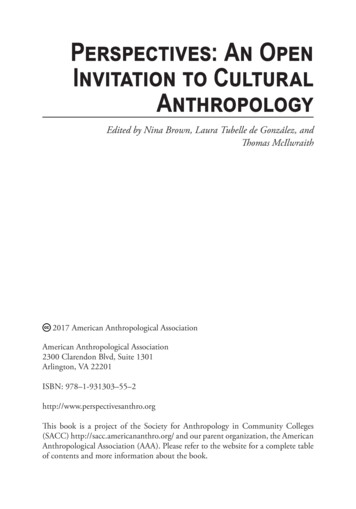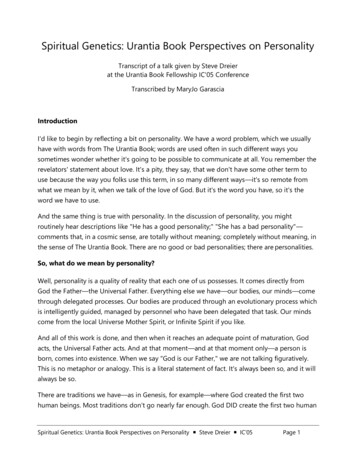
Transcription
Perspectives: An OpenInvitation to CulturalAnthropologyEdited by Nina Brown, Laura Tubelle de González, andThomas McIlwraith2017 American Anthropological AssociationAmerican Anthropological Association2300 Clarendon Blvd, Suite 1301Arlington, VA 22201ISBN: ro.orgThis book is a project of the Society for Anthropology in Community Colleges(SACC) http://sacc.americananthro.org/ and our parent organization, the AmericanAnthropological Association (AAA). Please refer to the website for a complete tableof contents and more information about the book.
PUBLIC ANTHROPOLOGYRobert Borofsky, Hawaii Pacific University, Center for a Public opology.org/LEARNING OBJECTIVESAs an example of public anthropology (following the modelof the Kahn Academy), Dr. Borofsky has created short10–15 minute videos on key topics in anthropology for introductory students. All 28 videos are available from thePerspectives: An Open Introduction to Cultural Anthropologywebsite. Identify examples of anthropologicalresearch that has contributed to thepublic good.INTRODUCTION Explain how the structure of academiccareers, topical specialization, andwriting styles contribute to difficultywith communicating findings fromacademic anthropology to a widerpublic. Define public anthropology anddistinguish it from academicanthropology and appliedanthropology. Assess the factors that contributeto a desire for public engagement inanthropology as well as the obstaclesto this engagement. Evaluate the ways in whichaccountability, transparency,collaboration, and the goal ofbenefitting others could contribute toreframing anthropology. Discuss actions that can be takenby anthropologists to facilitate socialchange.Was Julie Andrews right when (in the Sound of Music)she sang, “Let’s start at the very beginning, a very good placeto start?” Should authors follow her advice in writing textbook chapters by, at the beginning, explaining the organization of the chapter so readers will know what to expect andbe able to follow the chapter’s themes clearly? I cannot singDo Re Me half as well as Julie Andrews. But I will try tofollow her suggestion.This chapter begins with an outline of its organization—which topics follow others plus a little “secret.”After this introduction, the chapter turns to (a) two puzzlesstemming from anthropology’s interactions with the broaderpublic. It next (b) discusses how we might best define public anthropology given that different people interpret it indifferent ways, especially in respect to the field’s ambiguousoverlapping with applied anthropology. Building on thesepoints, the chapter then turns to (c) public anthropology’sfour main strategies for enhancing the discipline’s credibility with the broader public. The chapter concludes with (d)a section on facilitating change—guides for those who wantto help transform people’s lives for the better. Even withoutJulie Andrews singing, I trust this sounds interesting. Thechapter asks important questions and offers thoughtfulanswers that, I hope, will draw you into reflecting on thechallenges public anthropology faces as well as how itseeks to encourage anthropology to better serve the common good.Before beginning, however, I should share a secret.You will see throughout this chapter—as in most anthropological articles and books—a host of references in numberedfootnotes. You might ask why anthropologists are intent onPerspectives: An Open Invitation to Cultural Anthropologyhttp://www.perspectivesanthro.org/1
2Perspectives: An Open Invitation to Cultural Anthropologyciting colleagues extensively, especially when it is off-putting to students and the broader public.Seeing all the references with only a limited sense of who is being referred to and what they meancan be intimidating. Anthropologists use these references to show colleagues that they “know whatthey are talking about.” It demonstrates that they are familiar with key literature relating to a topic.The citations also serve another purpose. They reinforce the discipline. The more anthropologists citeeach other, the more they convey that anthropology is an important discipline with important thingsto say—just look at all the people and articles being cited. But intriguingly, many anthropologistsonly discuss the references in passing—usually for a sentence or two—just enough to show they arefamiliar with them.As a result, these citations should be taken with a grain of salt. They involve anthropologistsconveying, to each other, their intellectual mettle, their academic competence. Skip over them if theydo not seem interesting. Do not let them intimidate you. Why do I use them? Simply stated, I amwriting not only for you—a student reading this text—but also for colleagues who may review thischapter as well. They may be interested in exploring further some of the provocative things I say so Ineed to let them see my sources.Why do I bold certain passages? I do this for three reasons.1. It highlights key points in each section so the chapter is easier for you to read.Either before or after a bolded passage, there is additional material that amplifies thebolded text. This allows you to separate the key points from additional material thatdiscusses and/or explains the central points being made.2. If you are in a rush, you can skim the chapter’s main themes by focusing on thebolded passages. You will get the main ideas but not the details and explanations thatclarify the bolded points.3. You can use the bolded passages to review the chapter once you have read it. Goback through the bolded points and see if you remember the chapter’s key themes. Ifyou come across a point about which you are unclear, simply read the neighboringtext to clarify what the bolded passage is about.TWO PUZZLESTurning to the chapter’s key themes, let’s start by exploring two puzzles. The first puzzle:By the time you reach this chapter, I hope you see how exciting anthropology can be. It deals withall sorts of intriguing questions about the human condition—how humans and their societies haveevolved through time, what life is like in unfamiliar places, what human differences suggest aboutour commonalities, and how understanding them may facilitate better human relations. And yet,most of the widely read, popular books that deal with anthropological issues—books that winprominent prizes and are bestsellers—tend to be written by non-anthropologists. Why is that?The second puzzle: Anthropologists have done much good in the world—not only helping to enrich human understanding of our past and present but also facilitating concrete changes that improvepeople’s lives. Yet anthropology’s positive efforts have not often been highlighted in the world’snewspapers or other media outlets. Again, why?Starting with the first puzzle, why non-anthropologists tend to write the bestselling anthropologically oriented books, let me offer three examples. Reading this textbook, you can see that
Public Anthropology3books on the evolution of human societies, including how the West (meaning Western Europe, Canada, and the United States) became more developed than the “Rest” (i.e., non-Western societies), arestandard anthropological fare. Many anthropologists have written about these topics. But only onebook has become wildly popular: Jared Diamond’s Guns, Germs, and Steel: The Fates of HumanSocieties (1997). The book won the 1998 Pulitzer Prize for General Non-Fiction, was the subject ofa well-received PBS National Geographic special, and remained on the New York Times bestseller listfor almost four years. Diamond studied anthropology as an undergraduate but obtained a doctoraldegree in physiology. Starting out as a professor of physiology at University of California, Los Angeles, he is now a professor of geography.Katherine Boo’s Behind the Beautiful Forevers: Life, Death, and Hope in a Mumbai Undercity (2012) is an insightful ethnography of life in an Indian slum. It provides a vivid sense of howpeople, despite overwhelming difficulties, not only are able to survive but at times are filled with hopefor a better life. In the tradition of the best ethnographies, the book allows readers to understandand appreciate how the main characters navigate their lives through conditions that might surprise,and perhaps shock, some. Behind the Beautiful Forevers won the 2012 National Book Award for nonfiction and the Los Angeles Times Book Award and has been a New York Times bestseller. While Boospent a number of years studying the people of Annawadi (a Mumbai slum near the airport), she isnot an anthropologist. She is an investigative journalist, formerly of the Washington Post and now awriter for the New Yorker.Anne Fadiman’s The Spirit Catches You and You Fall Down (1997) is a detailed, extended casestudy in medical anthropology that documents the miscommunications that developed between aLaotian refugee Hmong family and the medical staff of a Merced, California, hospital treating thefamily’s epileptic daughter, Lia. It offers a nuanced, sensitive ethnographic account of the problemswell-intentioned people face when they talk past one another. As the New Yorker observed, “Fadimandescribes with extraordinary skill the colliding worlds of Western medicine and Hmong culture.”1The book has received numerous honors, including the National Book Critics Circle Award for General Nonfiction and the Los Angeles Times Book Prize for Current Interest, and almost one millioncopies have been sold. (Sales of most anthropology books are around 2,000 copies). Fadiman refersto anthropologists but is not one herself. When she wrote the book, she was a journalist and editor.She is now a writer in residence at Yale University.There is no doubt that anthropologists would like to be read and recognized by audiences beyondthe discipline. Such an accomplishment means more than just selling lots of books; it means havinga public impact that stretches beyond the university.Some anthropologists have been popular authors, most prominently, perhaps, Margaret Mead.Her 1928 book, Coming of Age in Samoa, which compared sexual experiences of Samoan girls withthose of American girls, sold hundreds of thousands of copies. But such anthropologists are relativelyrare today. Clifford Geertz won the National Book Critics Circle Award for Criticism in 1988 andRobert Levy was a finalist for the National Book Award in 1974, but neither book sold particularlywell beyond academia. Recently, another anthropologist, David Kertzer, won the Pulitzer Prize. Buthis book, The Pope and Mussolini: The Secret History of Pius XI and the Rise of Fascism in Europe, is,as its subtitle suggests, focused on details of European history, a topic outside the anthropologicalmainstream.My point is this: Few anthropologists writing on anthropological themes today are widely readbeyond the discipline. The anthropology-oriented books that are best sellers and win promi-
4Perspectives: An Open Invitation to Cultural Anthropologynent awards tend to be written by non-anthropologists, and when an anthropologist writes anaward-winning book, it tends to be on a less-anthropological subject.What gives? Clearly, anthropologists have the skill and interest to write for the broader public. Isuggest, in part, that it is a matter of priorities. Many anthropologists would enjoy a large, publicaudience (A survey in the Chronicle Review in 2016 indicated that 83 percent of the Chronicle subscribers sampled believed that academics should do more to shape public debate.)2 For most juniorprofessors, however, an even higher priority is promotion and tenure. To achieve these, they mustdemonstrate to their faculty review committee that they can produce serious, professional work. Akey marker, if not the key marker, of significant professional work is the degree to which academiccolleagues cite one’s publications in their publications. It is often referred to as an author’s intellectualimpact.While there are other standards for assessing promotion and tenure, committees tend to fallback on cited publications in assessing a faculty member’s achievements because clear metricsexist for the degree to which colleagues cite one’s work. All committee members have to do is logon to Google Scholar, for example, and type the individual’s name in quotes. (It also helps to includethe author’s discipline since Google Scholar does not differentiate between two scholars with thesame name.) Until recently, there were no metrics for assessing an author’s citations in the publicpress. Almost by default, then, anthropologists seeking promotion needed to demonstrate their competence through academic citation-oriented metrics.There is also the matter of maintaining appearances. Promotion committees often encourageanthropologists to conform to certain professional standards. Mary Douglas, a famous British anthropologist, in a book entitled Purity and Danger (1966) emphasized social structures (includinganthropology departments) “are armed with articulate, conscious powers to protect the system; theinarticulate, unstructured areas . . . provoke others to demand that ambiguity be reduced.”3 For some,seeking to speak to nonacademic audiences challenges academic practice. It creates ambiguity regarding who anthropologists should be writing for and to what end. Anthropologists usually need to be ofhigh status to challenge academic practice in this manner safely. (Note that Margaret Mead, who wasworld famous, never held a senior academic position at a prominent university though, intriguingly,many universities asked her to speak at them.)Moreover, anthropologists tend to focus on fairly specialized topics. In 1980, Eric Wolf wrotea famous editorial in the New York Times, stating “they divide and subdivide, and call it anthropology.”4 He was objecting to anthropology’s tendency to turn from broad, holistic analyses to morelimited, specialized ones. As part of their academic training, anthropologists usually learn to focus onnarrow, specialized subjects. It enhances their status because, with a narrow niched subject, facultymembers can be familiar with most of the associated professional literature. That is more difficultwith a broad topic. While the books by Diamond, Boo, and Fadiman all deal with specialized topics,their authors are masters at showing how their topics fit into broader concerns that interest a range ofreaders. Many anthropologists, unfortunately, are not experienced in writing in this manner.I face this issue as editor of the California Series in Public Anthropology. The series encouragesscholars in a number of disciplines to write about major social concerns in ways that help the broaderpublic understand and address them. Two presidents (Mikhail Gorbachev and Bill Clinton) andthree Nobel laureates (Amartya Sen, Jody Williams, and Mikhail Gorbachev) have contributed tothe series as authors of books or forwards. Given its prestige, many anthropologists are eager to writefor the series, but it is often a struggle for them to write for broad audiences in exciting ways. Giventheir desire for promotion and tenure, it is often a bridge too far.
Public Anthropology5There is another often-unstated reason that I describe later in this chapter but want to brieflytouch on here. It relates to cultural hegemony, a term associated with the Italian Antonio Gramsci. We might define cultural hegemony as the means by which a dominant group or perspectiveorders various beliefs, explanations, values, and worldviews so that they seem to be not only thenorm—the expected way to behave—but also justify the status quo as natural andbeneficial, thereby leaving the dominant group in control. Essentially, it is a means ofdominating without having to apply overt power or violence.An example of such cultural hegemony is the New York Times’ review of Robert and SarahLeVine’s Do Parents Matter? The book’s theme—that American parents should be less tense inraising their children—should attract a relatively broad range of readers, which presumably is whyit was reviewed in the New York Times Book Review (2016).5 The problem is that the LeVineswere not able to step outside of an academic writing style to show the relevance of their ideas toa broad audience. Let me quote from part of the review:Firm takeaways . . . are rare, though, peppered inside a dizzying survey of firsthand experiencesand other studies: on toilet training, eating patterns, tantrums . . . It’s not that any one culturehas it figured out, but that practices “vary much too widely across cultures for us to acceptuncritically the supposition that the mental health of American children is being put at riskby ‘insensitive’ infant care.”. . . The LeVines have deep understandings of cultural contexts, allowing them to offer howto-style pieces of advice: Co-sleeping makes life easier for parents and does not inhibit childdevelopment; a “skin-to-skin style of infant care” can foster more compliant children. Buta combination of endlessly complicated cultural contexts and the limits of in-field researchmake these conclusions less than useful for Western readers. Toilet training is easier whenconducted outdoors or on dirt floors. Compliance is more achievable when the child is putto work at age 6.Most frustrating of all: “We don’t have all the evidence needed to settle the question ofwhether the parental practices described in this book inflict harm on adult mental health.”Someone should do that research and write a book about it. I would read it.The LeVines are senior anthropologists who need not worry about tenure/promotion review committees. Their book addresses a significant topic. Wh ile attempting to write for a wi der au dience.They were not able to move outside the academic styles of presentation with which they were familiarand comfortable. Instead, they remained within the cultural hegemonic framings of anthropologyand the academy.The same pattern can be seen in the rise of internet sites associated with anthropology. I nprinciple, the changing media landscape should widen readers’ interests, presenting them with a richwealth of information. But more frequently than not, readers focus on websites that fit their existinginterests and often remain within their own intellectual “bubbles.” One sees this withanthropological efforts to reach a broader public with websites such as Sapiens andAnthrodendum, which seek to make anthropological insights available to a wide audience. But theway they frame the issues, choose topics to cover, and present the information limit their readership.
6Perspectives: An Open Invitation to Cultural AnthropologyIn brief, despite a desire to reach wider audiences, we see the difficulty even senior anthropologistshave in escaping the hegemonic frameworks of their discipline and academia. They are uneasy operating too far outside their comfort zones, too far outside the frameworks they have grown accustomedto as scholars.Let’s turn to the second puzzle—why anthropologists tend not to be more recognized forhelping others and nourishing the common good. Again, we will consider three examples. Thefirst concerns individuals faced with arbitrary bureaucratic demands. In 1978, six elderlyNative American women from the Bannock and Shoshoni tribes in Idaho were accused by a localsocial services agency of fraud and required to pay 2,000 each in restitution. The fraudaccusation was based on the belief that these women had misled the U.S. government abouttheir incomes and, hence, their eligibility for Supplementary Security Income support.Anthropologist Barbara Joans acted as an expert witness for the women in court. She emphasizedthat the women had an imperfect grasp of English and, as a result, a limited understanding ofgovernment regulations. Joans “concluded that the social services personnel and the Indian womenwere operating at different levels of English and cultural understanding . . . [consequently] thewomen would not have been able to comprehend what was expected of them.”6 The judge agreedwith Joans’ conclusion and decided that, henceforth, “social services personnel would have touse an interpreter when they went to the reservation to explain programs and theirrequirements.”7 The women did not lose their government benefits.The second example involves a study of a government program—the ExperimentalTechnology Incentive Program (ETIP) set up by the U.S. Department of Commerce8 thatsought to stimulate innovation among American companies. Gerald Britain, an anthropologist,spent more than two years observing the program and provided an in-depth evaluation of itseffectiveness. Britain suggested that, despite its good intentions, the program was caught in astructural bind. Companies had little incentive to follow through on the program’s suggestionsand had their own priorities. Moreover, the program had a high rate of staff turnover, whichmeant that its projects were often erratically supervised. What ultimately proved the program’sundoing was its inability to spend all of the funds allocated to it. Its surplus of roughly 2 millionbrought the program to the notice of prominent administrators, and, after a brief investigation,the Commerce Department terminated the program. Through his fieldwork, Britain was able toexplain why a government program might fail despite its value and good intentions.The third example concerns the Vicos Project, which is often praised within the disciplineas an important effort by anthropologists to assist with third world development. In 1952,guided by Alan Holmberg, Cornell University leased “Vicos,” a Peruvian highland hacienda(farm) with roughly 1,800 Quechua-speaking residents, to conduct agricultural experiments.“Between 1952 and 1957 Holmberg, with colleagues and students, initiated a set of social,economic, and agrarian changes . . . By the end of a second lease in 1962, sufficient politicalpressure had been brought to bear . . . to force the sale of Vicos to its people.”9 Despite thispositive result, some have challenged the project’s overall success. According to Paul Doughty, whoparticipated in the project and revisited Vicos years later, “In the decades since the end of theproject [officially in 1966], the community experienced numerous successes as well as failures asan independent community. Its attempts to diversify the economic base were often thwarted [byothers] and the farming enterprise was affected by plant diseases [and] bad market prices . . .For several years from 1974–80, self-serving government manipulations left the people in thecommunity confused, corrupted their leadership, and eroded their confidence.”10 Still, Doughtyconcluded that the Vicosinos had “altered their society from one of denigrated serfdom
Public Anthropology7and subordination to become an autonomous community of Quechua highlanders fending forthemselves on a par with others in Peru’s complex and uncertain milieu.”11Many other examples like these demonstrate anthropology’s ability to empower people andfacilitate good, but they often go unnoticed by the broader public. Why? Let me suggest fourreasons. You are welcome to add others.First is the complexity of change. Consider the U.S. Civil Rights Movement. It led to twomajor laws that have helped transform American society: the Civil Rights Acts of 1964 and theVoting Rights Act of 1965. They were a long time coming—a century, in fact, after passage of theThirteenth Amendment in 1865 (formally ending slavery). It is difficult to pinpoint one event thatled to their passage. Part of the impetus for the Voting Rights Act stemmed from the violencefaced by black marchers, including Dr. Martin Luther King, Jr., in Selma. Without the organizingof Dr. King and the Southern Christian Leadership Conference (SCLC), the actions of theNational Association for the Advancement of Colored People (NAACP) and the StudentNonviolent Coordinating Committee (SNCC), the rise of television that allowed millions towitness the violence of Selma, the political skills of President Lyndon Johnson, and a coalition ofliberal Democratic and Republican legislators, the bills would never have passed. With so manyinvolved, it is hard to specify one event or person that was the tipping point that led to theirpassage.Anthropologists played a role in the Civil Rights Movement. Before World War II, Franz Boasand Margaret Mead emphasized that changing social environments could lead to significantbehavioral changes. In 1939, Hortense Powdermaker wrote an insightful ethnography of blacklife in Mississippi that dealt with economic and political barriers that limited black success. Eventhough Boas, Mead, and Powdermaker helped develop the intellectual framework for the1964 and 1965 laws, they are rarely mentioned in relation to the Civil Rights Movementbecause they were not directly involved in the events that led to the bills’ passage.A second factor was noted by Shirley Fiske, who described anthropologists as frequentlyworking from the bottom up. Anthropologists are not highlighted as key change agents becausethey do their work away from the political spotlight, slowly chipping away at the problem.Regarding anthropological work on climate change, Fiske writes:Anthropologists have been involved at every step, from the formation of interagency committeesin the 1990s, to membership on the National Academy of Sciences studies, to contemporaryefforts to insert the social and power dimensions into concepts like “vulnerability assessment”that are building blocks of the National Climate Assessments required by statute. It is not justone person, but the continuing insertion of the “bottom up” approach.12Anthropologists often provide important data regarding what happens “on the ground,” butthose who actually make changes usually get the credit. In terms of the 1964 and 1965 laws, thespotlight was focused on the major political figures involved—Martin Luther King andPresident Lyndon Johnson.A third factor relates to anthropologists working in “third world” settings studying the lesspowerful on the margins of Western society. President Obama’s mother, Ann Dunham, was ananthropologist who conducted valuable fieldwork in Indonesia, but to the broader public, themain value of her work was that she took her son along with her, broadening his internationalperspective. Helping six elderly Bannock and Shoshoni women is valuable. The Vicosinos whogained control over their land appreciated Cornell’s efforts. But such efforts usually do not draw
8Perspectives: An Open Invitation to Cultural Anthropologymuch attention outside of anthropology.Fourth, given the everyday onrush of information, references to anthropologists in the newsmedia rapidly fade from the spotlight. Ann Kingsolver, an anthropologist at University ofKentucky, was cited in an Economist article on Appalachia in 2015, but the Economist provided itsreaders with many other articles on the United States as well. With a host of new articles the followingweek, she became just one voice among many for the month.13For this situation to change, anthropologists need to demonstrate the good they do on anongoing basis. Presently, the benefits they bring appear to be episodic—a bit here, a bit there. Forthe public to take greater notice, the discipline as a whole rather than a few individuals mustconsistently demonstrate how anthropology nourishes the common good. Sadly, it does not dothat yet.I hope that the preceding discussion has helped to unravel the two noted puzzles—why the mostpopular anthropological works today tend to be written by non-anthropologists and why anthropological efforts to do good are often less recognized by the broader public than they might be. Manyanthropologists wish to be publicly recognized outside the discipline, but both overt andcovert frameworks reinforce the status quo. Facilitating change will involve refocusing thediscipline away from the specialized interests and academic priorities that dominate it now andtoward work that directly benefits society more broadly, that serves the common good.I make this point about structural constraints and hegemonic frameworks before definingpublic anthropology for an important reason. While anthropologists are often eager to pushtheir ideas and deeds out to the broader public, they tend to pass over the need to address thesubtle but significant covert obstacles they face.In the next section, you will see how different anthropologists perceive public anthropologyand how concern for public engagement has varied over time. I leave the tricky part—howanthropologists might overcome the structural constraints limiting public engagement—until later.DEFINING PUBLIC ANTHROPOLOGYLet me offer a brief definition of public anthropology: Public anthropology focuses on theinterface between anthropology as an academic discipline and the broader public that supports and,ideally, finds much value in it. This works as a definition you can recite to others. It emphasizesthe role the public plays in supporting anthropology as well as that anthropology is not an academicisland unto itself. Still, it does not address certain subtleties.Public anthropology has gone from a term I created in the 1990s as a name for theCalifornia Series I edit to a term that now has more than 100,000 links in Google Search. Icoined the term because it represented a goal of the series: addressing public problems in public ways.Public, in this sense, contrasted with academic styles of presentation. As phrased in the front matter ofearly books in the series, “the California Series in Public Anthropology emphasizes the anthropologist’srole as an engaged intellectual. It continues anthropology’s commitment to being an ethnographicwitness, to describing in human terms how life is lived beyond the borders of many readers’experiences. But it also adds a commitmen
(Sales of most anthropology books are around 2,000 copies). Fadiman refers to anthropologists but is not one herself. When she wrote the book, she was a journalist and editor. . to Cultural Anthropology-In , , pdf. .










